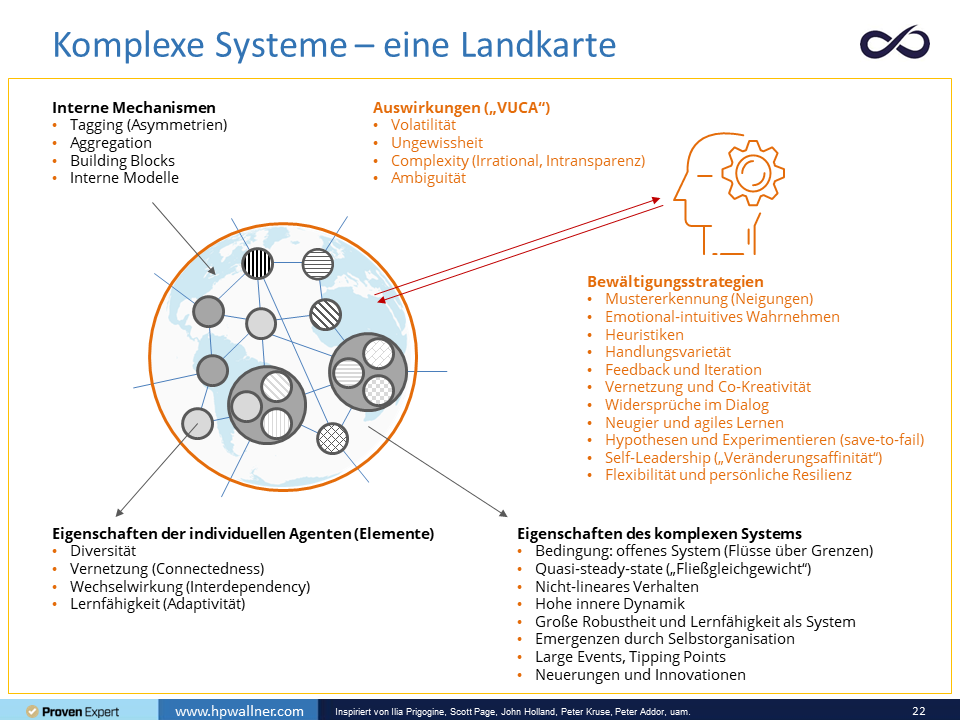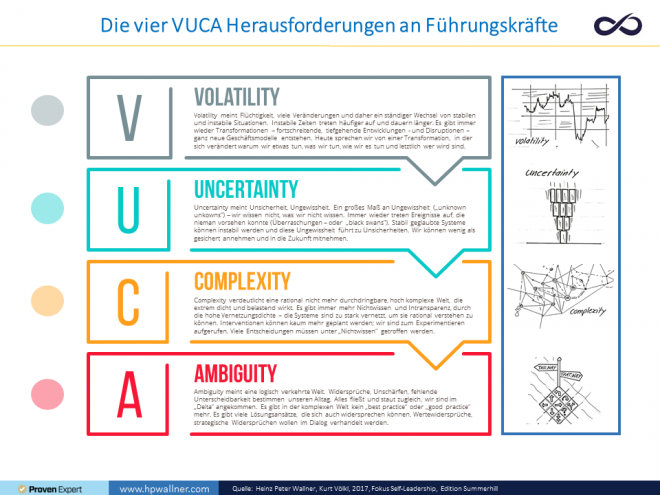This post is also available in: German
Disentangling complexity
We cannot really understand the complexity and behaviour of complex systems. These systems elegantly elude our intelligence. Nor can they be controlled; not because they are stubborn, on the contrary, they are bursting with dynamism and flexibility. They cannot be controlled because they only follow local rules and are unaware of higher-level instructions. In the world of complexity, responsibility is local. With the 7th article on “Strategies for high complexity” I would like to present a simple “map of complexity”. Maybe this is also helpful for you.
To make knowledge productive, we must learn to see both the forest and the individual tree. We must learn to make connections.
(Peter Drucker, 1993)
Attempts to define complexity
All of the above we have already known for a long time. And we are still confused when we discuss complexity and “master” the behaviour of complex systems in a leadership role. Depending on the sources we use to approach the topic, we find very different approaches, models and considerations.
What many people think
Most of the authors agree on a few points when they describe what complexity is. Mostly it goes in this direction: the system consists of many and very different elements that are networked and interact. Others speak of an open system through which matter, energy and information flow. Then there are the modelers who program complex systems. They think that diversity, aggregation, non-linearity, buidling blocks, internal models and tagging are the properties and mechanisms of complex, adaptive systems.
The VUCA world
A completely different species is approaching us with the VUCA acronym and wants to qualify the challenges that complex systems bring with them. Some experts believe that we should not attempt to define anything because complexity cannot be grasped.
Attempt of a map
How are executive trainers supposed to deal with the topic of complexity with the managers when we allegedly cannot even grasp it? It is not very satisfying when everyone, depending on their mood, just takes up one of the many endings of the story and goes into detail. All too often, managers are only confronted with the VUCA world and VUCA strategies. After a few attempts this was no longer enough for me. So I started to sketch a map that can bring a little more clarity into the confused world of complexity. It is only a beginning and neither complete nor “right”; it is helpful in my work. Every comment will contribute to further development!
The map of complexity (first sketch)
Possible approaches
I want to describe complex systems from several perspectives. We agree that they consist of several elements. And first of all, it is possible to identify characteristics or qualifications that all elements of complex systems have and that distinguish them. These four qualifications are (see Scott Page): We describe a system as complex when it consists of units (agents) that are different, that are interdependent, that are networked and that are able to adapt to new circumstances. In short, these four qualifications are:
- Diversity
- Connectedness
- Interdependency
- Adaptivness
Mechanisms in complex systems
John Holland describes not only the properties but also mechanisms that take place in complex systems. He points out:
- Tagging – the symmetry is broken by markings
- Aggregation –the elements form clusters (according to John Holland this is a property)
- Building Blocks – complex systems create building blocks that they use again and again
- Internal Models – successful patterns of action are formed
The properties of complex systems
In addition to the four qualifications of the individual elements, we can also identify a whole range of characteristics that complex systems have and that distinguish them. It is actually these characteristics that make such systems so extremely interesting and exciting. The important properties of complex systems are:
- The system must be an open system (flows across borders) (this is a condition)
- Complexity is a quasi-steady-state (“floating equilibrium”) – the system is neither in equilibrium nor is it chaotic. It is the interesting state in between, a kind of highly dynamic “steady state” that can change and shift.
- Non-linear behaviour – we do not find our logical chain of cause and effect. The system does not behave linear, the events do not follow a “Gaussian distribution”.
- High inner dynamics – the system shows a high inner activity. We can see that the conditions are always changing.
- Great robustness and learning ability as a system – complex systems are adaptive. They are very good at dealing with disturbances and can also master dramatic situations. They are constantly learning and adapt to new environmental conditions.
- Emergencies through self-organisation – self-organisation forms “bottom-up” structures, completely without planning. Structures or characteristics emerge in the system which were not there before and which cannot be found in the elements. Macro and micro differ in their nature.
- Large Events, Tipping Points – only complex systems can produce large events. Suddenly a transformation can take place that has not announced itself. The interaction of the elements can have a positive feedback and create huge “waves”. Negatively when a tsunami forms, positively when a video on YouTube goes viral.
- Innovations and novelties – only complex systems constantly produce something new, which of course can also manifest itself in innovations.
The VUCA effects of complexity
When we humans observe a complex system, it shows its “VUCA side”. It contains at least these four challenges for every human being:
- V: VOLATILITY: Volatility stands for transience, many changes and therefore a constant change of stable and unstable situations. Unstable times occur more frequently and last longer. There are always transformations – progressive, profound developments – and disruptions – completely new business models emerge. Today we speak of a transformation in which it will change why we do something, what we do, how we do it and ultimately who will be.
- U: UNCERTAINTY: Uncertainty leads to insecurity. A large measure of uncertainty (“unknown unkowns”) – we do not know what we do not know. Again and again, events occur that nobody could foresee (surprises – or “black swans”). Systems that were believed to be stable can become unstable and this uncertainty leads to insecurities.
- C: COMPLEXITY: Complexity illustrates a highly complex world that can no longer be rationally penetrated, and which is extremely dense and stressful. There is more and more ignorance and intransparency, due to the high density of networking – the systems are too interconnected to be understood rationally. Interventions can hardly be planned; we are called upon to experiment. Many decisions have to be made under “not knowing”.
- A: AMBIGUITY: Ambiguity means a logically inverted world. Contradictions, fuzziness, lack of distinctiveness determine our everyday life. Everything flows and accumulates at the same time, we have arrived in the “Delta”. There is no longer any “best practice” or “good practice” in this complex world. There are many possible solutions, which can also contradict each other. Contradictions in values, strategic contradictions need to be negotiated in dialogue.
These challenges or effects of complexity on us humans are the consequence of the properties of complex systems. Non-linearity and high dynamics, emergences and tipping points cause volatility, uncertainty, intransparency and contradictions, because we cannot penetrate the system logically, it changes very dynamically and holds surprises in store.
Our coping strategies
There are a variety of proposed coping strategies for managers to overcome complex challenges. To be able to decide whether the problems are really “complex in nature”, I recommend the “Cynefin Framework” by Dave Snowden (cognitive edge), about which I will write articles in the future. If a leader is confronted with “complexity”, the following strategies are useful. For each strategy you will find a link to an article that takes a deeper look at the topic. Many of these strategies are discussed and implemented in companies today mostly under the title “agile”:
- Pattern recognition ( tendencies) and emotional-intuitive perception (1)
- Heuristics (2)
- Variety of action (3)
- Feedback and iteration (4)
- Networking and co-creativity (5)
- Contradictions in dialogue (6)
- Curiosity and agile learning (7)
- Hypotheses and experimentation (save-to-fail) (8)
- Self-Leadership („change affinity“) (9)
- Flexibility and personal resilience (10)
My tip for managers
Make friends with the basic attitude that you cannot fully understand complexity. Refrain from trying to master or control complexity. Rather, I advise a dose of modesty. It is quite sufficient to become friends with complexity and to see the many opportunities in addition to the inherent threats. The map of complexity can help to familiarize oneself with the subject.
Creativity can only be experienced under complex conditions and only from this creativity we will generate the solutions that can secure our future as mankind. So, if you have the possibility, then you create “complex conditions” in which people can work and create in “full complexity”! Start with your Team!
Sincerely,
Heinz Peter Wallner
I offer seminars on the topic of complexity „Inhouse“.
You can find more about my management and leadership training HERE.
Further articles on complexity and complexity training:
Warum sich ein Flirt mit der Komplexität lohnt
Teams als komplexe, adaptive Systeme
Komplexitätstraining und intuitive Entscheidungen
Freischwebende Aufmerksamkeit im Komplexitätstraining
Über die Unfähigkeit, mit hoher Komplexität umzugehen (1/5)
This post is also available in: German




